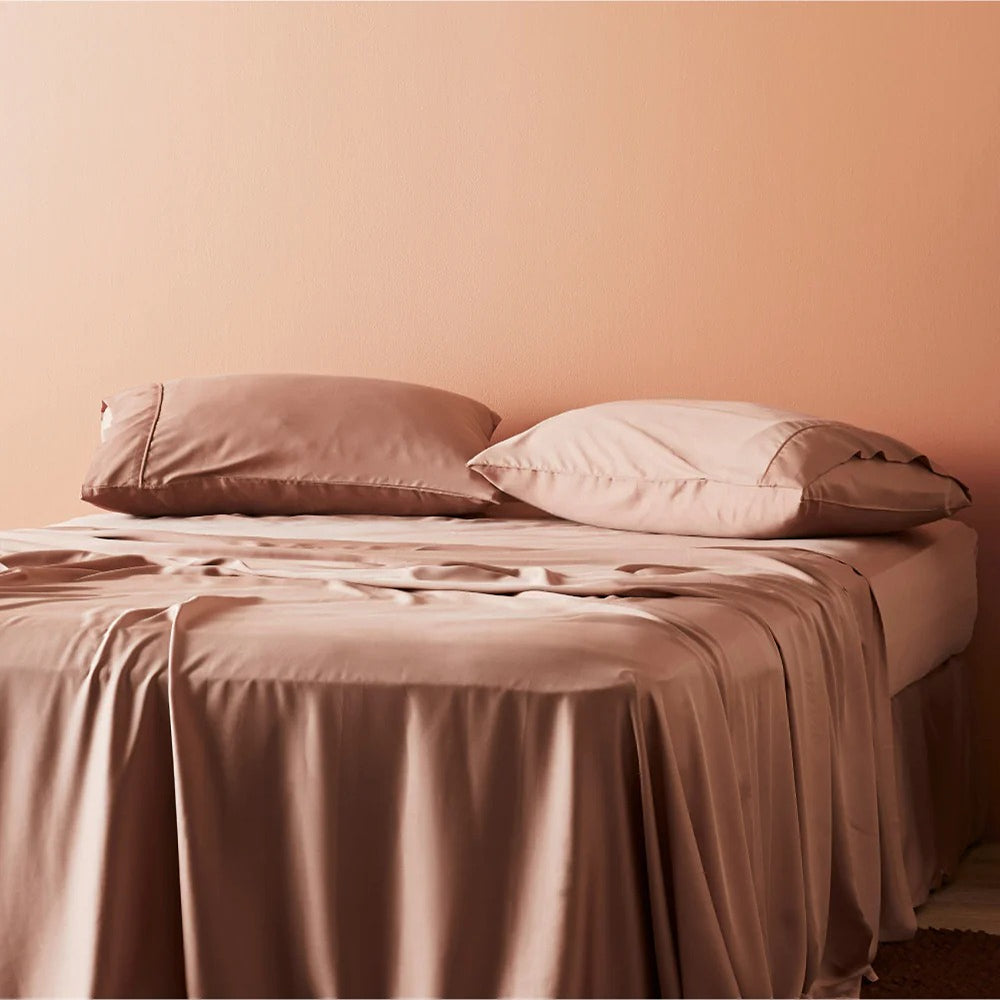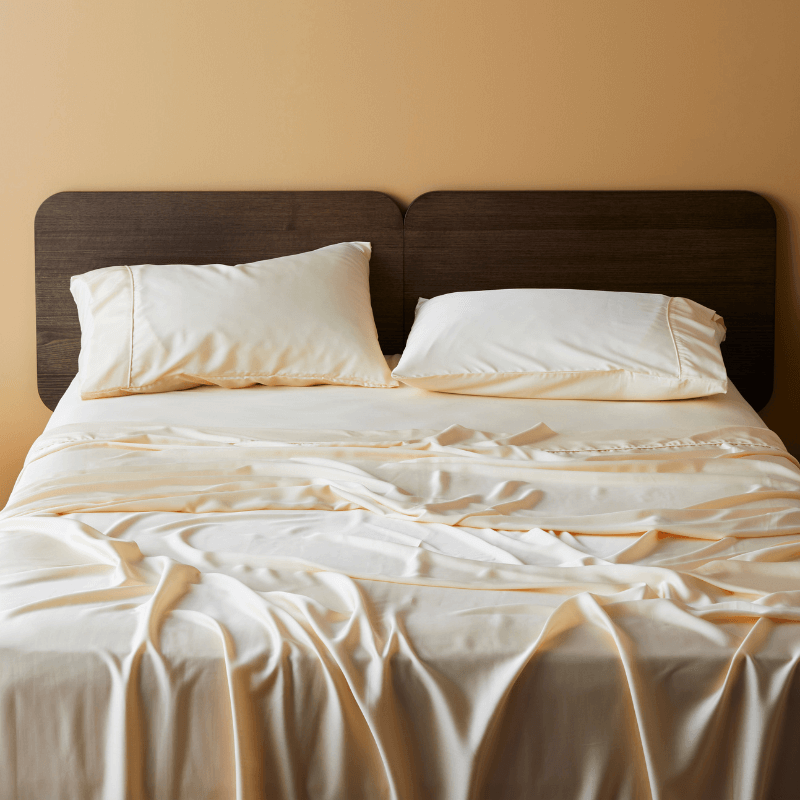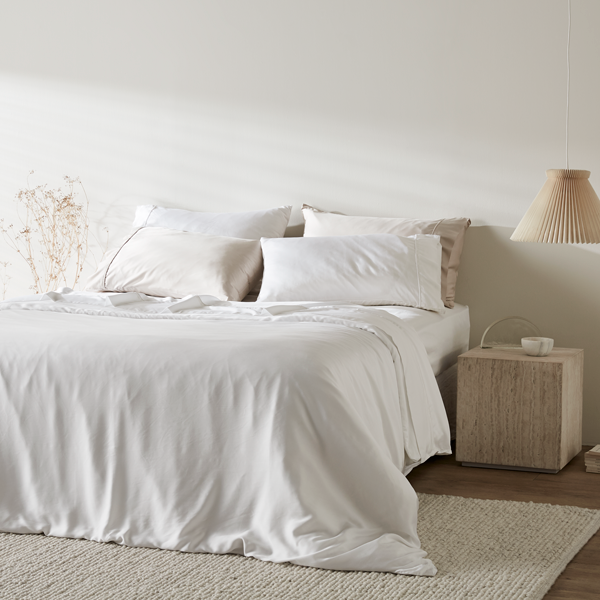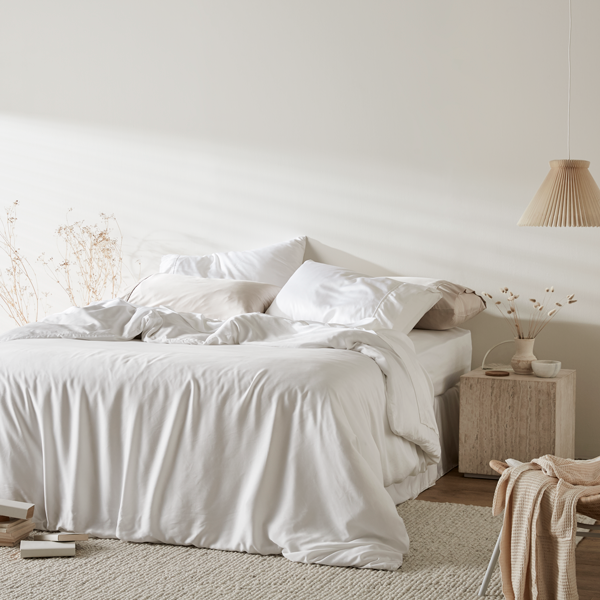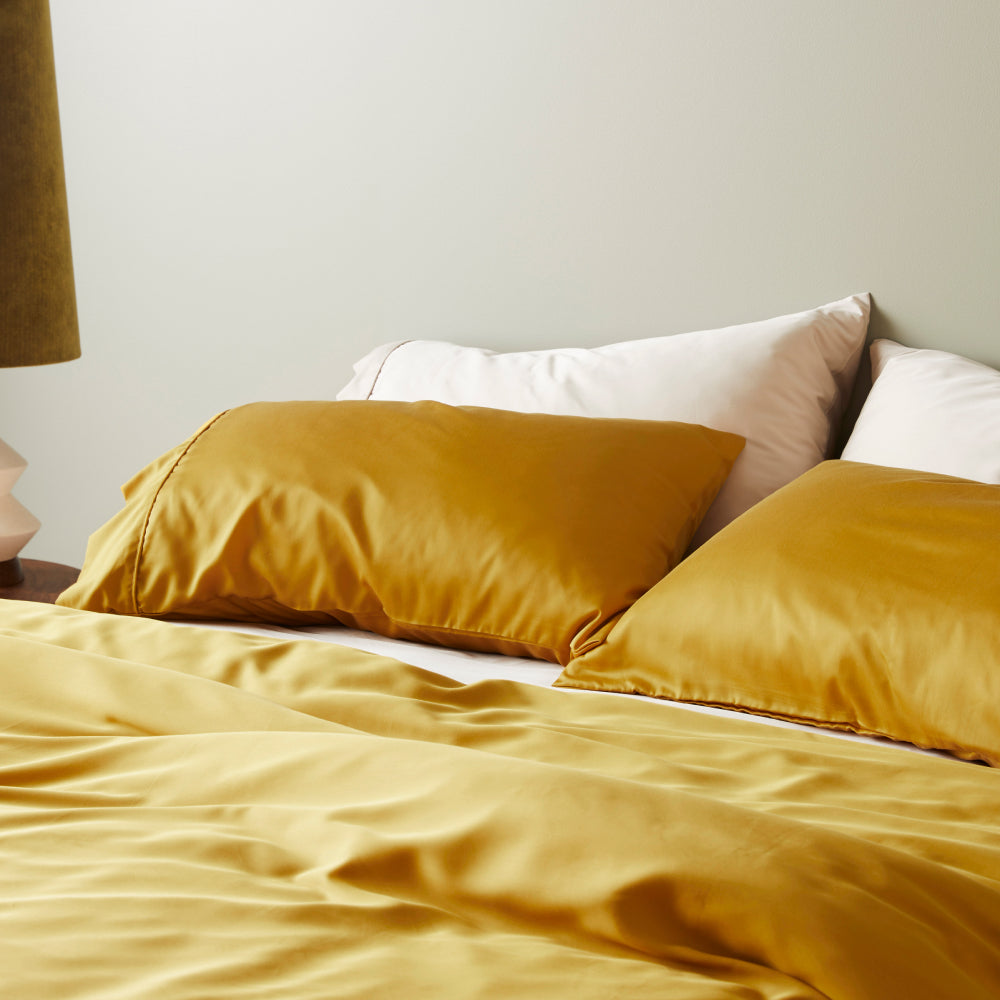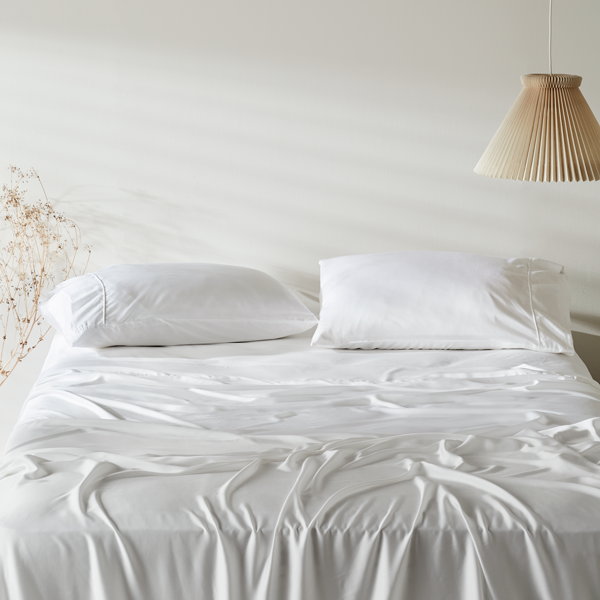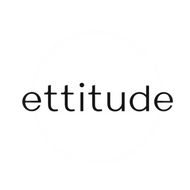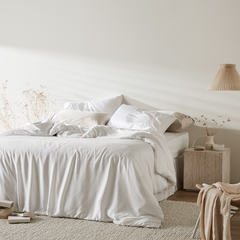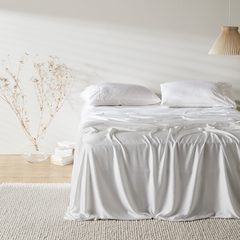We’ve looked more closely at popular bedding materials to help you find the best option. When it comes to bamboo bedding, there are three main types of fabrics: viscose, modal, and lyocell. These are all known as “cellulosic fibres” because the natural material that makes up the fibre is cellulose, a component found in all plants.
Unlike other man-made fibres, viscose, modal, and lyocell aren’t synthetic. They’re produced from cellulose, typically derived from wood pulp and, more recently, bamboo. They’re neither synthetic fibres (like those made from petroleum) nor natural fibres (like those directly produced from plants or animals, such as wool).
However, these bamboo fibres share more similarities with natural cellulosic fibres (like cotton, flax linen, hemp, and jute) than thermoplastic, petroleum-based synthetic materials like nylon and polyester.
Lyocell bamboo, modal, and viscose are made by breaking down raw materials into pulp, dissolving them in a solvent, and then forming the fabric’s fibres. While all three fabric types are derived from the same base material, they differ significantly. The method used to extract cellulose from the bamboo pulp plays a big role in the characteristics of the resulting fabric. Let’s explore the different types of bamboo fabrics available today.
Viscose
Viscose is the first generation of these fibres and the foundation upon which further developments were made. It’s often called viscose rayon or art silk (short for “artificial silk”) in the textile industry. It’s known for its high lustre, which gives it a shiny appearance.
There are several processes for manufacturing viscose, with variations in the chemicals used and their environmental impact.
The production process for viscose, modal, and lyocell involves purifying cellulose, often from trees, and converting it into a soluble compound. This solution is then passed through a spinneret (similar to a showerhead) to form soft filaments and later regenerate into almost pure cellulose in the final product.
Viscose fabrics can have different strength and stretch properties depending on the spinning process used. Regular viscose is the most common and is typically found in clothing and home furnishings; it’s labelled as “rayon” or “viscose.” A key feature of regular viscose is its low wet strength, which means it can lose stability or shrink/stretch easily when wet.
Viscose’s cellulosic base has many properties similar to cotton or other natural fibres. It’s more moisture-absorbent than cotton, soft, comfortable to wear, drapes well, and can be dyed in a wide range of colours. It doesn’t build up static electricity or pill unless the fabric is made from short, low-twist yarns. Viscose doesn’t insulate body heat, making it ideal for hot and humid climates.
Viscose has moderate dry strength and abrasion resistance, but like other cellulosic fibres, it’s not resilient and will wrinkle. Viscose can be ironed at slightly lower temperatures than cotton.
Unfortunately, viscose production uses corrosive chemicals, some of which can contaminate water if not disposed of properly. The two toxic chemicals used in viscose bamboo products are sodium hydroxide and carbon disulphide, which contribute to pollution. As a result, viscose is less environmentally friendly than many people think. Just because something is made from bamboo, a sustainable material, doesn’t mean the production process is eco-friendly.
Modal
Modal is a second-generation regenerated cellulosic fibre and a variation of rayon. Modal’s standout features are its high wet strength and extra softness. It’s often described as “as soft as a feather” and “the softest fibre in the world.” Modal’s softness makes it perfect for body-contact clothing like lingerie and undergarments, in addition to general apparel.
Bamboo modal fabric uses a modified production process that’s less resource- and chemical-intensive than viscose, making it a more sustainable option. However, it’s still not the most sustainable choice for bamboo sheets. As the next generation of bamboo products, modal offers several benefits:
- Machine washable: Modal’s high wet strength allows it to be machine-washed and tumble-dried without shrinking or losing shape. It’s durable and maintains a soft, silky feel, making it a popular choice for clothing, outerwear, and household furnishings. Modal can be easily dyed in tone-on-tone colours, and eco-friendly dyes can be used depending on the manufacturer.
- Water-absorbent: Modal is about 50% more water-absorbent per unit volume than cotton. It’s designed to dye like cotton and retains its colour even after washing in warm water. Modal remains absorbent, soft, and supple even after multiple washes.
- Fade-resistant: The colours in the modal tend to stay brilliant and intense. Unlike 100% cotton textiles, modal doesn’t grey over time. Bleaching or whitening may not be necessary, but if you do use these products, choose environmentally friendly options.
- Soft: The smooth surface of modal fibres prevents mineral deposits from water, such as lime scum, from building up on the textiles, keeping them soft even after repeated washes.
Bamboo Lyocell
Bamboo lyocell fabric is the most recent generation of bamboo fabrics. So, what sets bamboo lyocell apart from other types of fabric? While modal introduced softer and more durable fabrics, lyocell aimed to make the production process more environmentally friendly. Instead of harsh chemicals, bamboo lyocell uses organic solvents and nanofibrils, making it moisture-wicking, silky-soft, and better for the environment.
The production process for bamboo lyocell fabric is a closed-loop system, which makes it a greener option. Bamboo is naturally resistant to pests, so there’s no need for chemicals like herbicides and pesticides, making it easier to grow with less water. Once the bamboo is turned into pulp, it’s dissolved in an organic compound to create a thick solution, then spun to create fibres. The organic compound is recovered and recycled. The benefits of bamboo lyocell include:
- Wicks away moisture: Lyocell has many advantages over viscose and modal, particularly its moisture-absorbing properties. Lyocell’s ability to absorb excess liquid (like sweat) and quickly release it into the air makes it resistant to odours.
- Minimises skin irritation: Rough fibres can cause skin irritation. Thanks to nanofibrils, the microscopic surfaces of lyocell fibres are smoother than those of modal, cotton, and wool. This smooth texture, combined with excellent moisture absorption, makes lyocell textiles feel soft and comfortable against the skin, making this fabric ideal for activewear, clothing, and bedding for sensitive skin.
- Prevents bacteria: Lyocell naturally prevents bacterial growth (which causes odours) without needing chemical treatments that can trigger allergies and harm the environment. Bacterial growth is reduced by the fibre’s moisture management properties, which absorb moisture from the skin and transport it to the inside of the fibre, preventing a water film where bacteria could grow.
- Hypoallergenic: Bamboo lyocell is hypoallergenic, meaning it’s unlikely to cause allergic reactions in sensitive individuals. This makes it a popular choice for clothing and home furnishings for people with Multiple Chemical Sensitivities (MCS), allergy sensitivities, psoriasis, and neurodermatitis. It’s also anti-static and doesn’t cling.
Is viscose, modal, and lyocell fabric sustainable?
Viscose, modal, and lyocell are made from renewable cellulosic plants like beech trees, pine trees, and bamboo; all three fibres are biodegradable. However, the most sustainable fabric is bamboo lyocell, which uses less water and energy in a closed-loop system that recycles water during the process.
ettitude’s bamboo lyocell CleanBamboo® is made from FSC-certified bamboo. Bamboo grows quickly without the need for artificial irrigation, pesticides, fertilisers, or genetic modification, which are sometimes used in “wood farms” for industrial purposes. Our products are also OEKO-TEX® 100 certified, ensuring they’re free from harmful chemicals and gentle on sensitive skin.
Lyocell production is a highly eco-friendly process and the most sustainable of these three fibres. The revolutionary aspect of lyocell manufacturing is the recovery and reuse of up to 99.8% of the solvent. The remaining solvents are treated in biological water treatment plants. The solvent isn’t acidic, and its safety has been proven in dermatological and toxicological tests. You could even dip your hand in it without any skin reaction (though it’s probably best not to keep it there too long). No toxic substances remain in the fibre.
The fibre yield per hectare from bamboo used in lyocell production is up to ten times higher than cotton. Cotton also requires 10-20 times more water than lyocell fibres. This means bamboo lyocell has a minimal impact on the earth and soil health compared to cotton.
Much of the environmental impact of textiles comes from how they’re cared for during use. With lyocell fabrics, there’s no need for fabric softeners, whitening agents, or bleach—all of which add to the consumer’s cost and introduce harsh chemicals into our environment.
Bamboo lyocell (aka CleanBamboo®) is a true achievement in eco-friendly fibre production. It’s derived from a renewable and sustainably harvested raw material, manufactured sustainably, and biodegradable at the end of its life cycle.
Which fabric is best for you?
When comparing the different types of bamboo fabrics on the market, it can be challenging to determine which ones are soft, durable, and eco-friendly. While bamboo bedding is made from a sustainable material, not all products are truly sustainable.
Choose wisely. Choose ettitude.
Make a difference and choose what's best for the planet. Try our sheet sets, duvet covers, and quilts. Our bedding is made from our patented CleanBamboo® lyocell, a breakthrough fabric with all the benefits of bamboo (hypoallergenic, thermo-regulating, moisture-wicking). It offers smoothness and comfort without the guilt associated with bamboo viscose. Browse through our extensive collection and join us in making the world a better place to live in, one step at a time.
FAQs
What’s the difference between bamboo viscose and bamboo lyocell?
Both bamboo lyocell and bamboo viscose are derived from bamboo but differ in texture, quality, and production process. Bamboo viscose is made using caustic soda, a harsh chemical that softens the bamboo fibers but eliminates the plant's natural benefits.
As a better alternative to viscose, ettitude developed CleanBamboo® lyocell, which is made using food-grade solvents and a closed-loop production process. This process retains the natural benefits of bamboo. The resulting fabrics are hypoallergenic, breathable, temperature-regulating, and moisture-wicking while minimizing the carbon and chemical footprint. The more gentle processing also retains more structure in the fiber of CleanBamboo lyocell, making it 59% more durable than bamboo viscose, according to 3rd party tests performed by Intertek.
Which one is better: bamboo lyocell or bamboo viscose?
Bamboo lyocell is superior to bamboo viscose in quality, longevity, health benefits, and environmental impact. Its production uses non-toxic solvents, giving it a uniquely luxurious texture, feel, and superior performance. These solvents also retain bamboo's hypoallergenic properties, resulting in sheets that are gentle on your skin. The soft, silky texture of CleanBamboo combined with the safe processing of the organic bamboo means these sheets are best for sensitive skin and an overall reduction in your exposure to toxins.
Additionally, CleanBamboo® has been scientifically proven to improve sleep by over 10%. (Dr. Dan Gartenberg, CEO of SleepSpace.com).
Finally, bamboo lyocell is also kinder to the environment than bamboo viscose, with significantly lower water consumption and carbon dioxide emissions.
Does bamboo viscose require a high level of energy to produce?
Yes, the production of bamboo viscose does indeed require a significant amount of energy. This is primarily due to the processes involved in transforming bamboo into usable fiber, necessitating intense heat and electricity. These energy-intensive processes contribute to a substantial carbon footprint associated with bamboo viscose production. This high energy consumption and resulting carbon footprint are important environmental considerations to take into account when evaluating the sustainability of bamboo viscose as a textile material.
Does bamboo lyocell use less water to produce compared to bamboo viscose?
Absolutely! Bamboo lyocell requires less water to produce than bamboo viscose. It is produced using a closed-loop method that reuses water, requiring less water than bamboo viscose. Additionally, it's more environmentally friendly as it avoids the toxic by-products associated with bamboo viscose production.
